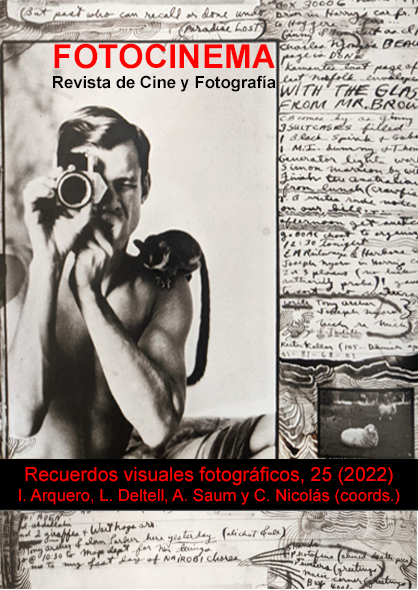Photography as a metaphor for memory. Comparative study of open shutter photography and average photography in contemporary art
DOI:
https://doi.org/10.24310/Fotocinema.2022.vi25.14478Keywords:
Contemporary Art, Photography, Ghost Image, MemoryAbstract
This article analyzes several contemporary art practices based on photography that can be interpreted as a metaphorical representation of images of memory and remembrance. We have divided these practices into two fields; firstly we will contextualize them by the analysis of their historical precendents and background; next, we will focus on the case studies of several contemporary artists. Thus, the first field includes artworks based on a continuous and extended record of time captured through photography so that we interpret them as related to a persistent experience of the past, as we observe in Michael Wesely´s, Hiroshi Sugimoto´s or Jim Campbell´s artwork. The second field encompasses a different photography model based on overlap and average which no longer reproduces an uninterrupted experience but rather a type of generic picture related to an archetypal image of media culture, as the artworks of artists like Corinne Vionnet or Jason Salavon reveal. Therefore, as we will set out, both strategies represent differently the experience of memory as a record of a temporality.
Downloads
Metrics
Publication Facts
Reviewer profiles N/A
Author statements
Indexed in
-
—
- Academic society
- N/A
- Publisher
- Universidad de Málaga
References
Anderson, S. F. (2017). Technologies of vision: the war between data and images. The MIT Press.
Aumont, J. (1992). La imagen. Paidós.
Berger, J., y Mohr, J. (2007). Otra manera de contar. Gustavo Gili.
Cartier-Bresson, H. (2007). El instante decisivo (1952). En J. Fontcuberta (Ed.), Estética fotográfica (pp. 221–236). Gustavo Gili.
Doane, M. A. (2012). La emergencia del tiempo cinemático. La modernidad, la contingencia y el archivo. Cendeac.
Draaisma, D. (1998). Las metáforas de la memoria. Una historia de la mente. Alianza.
Fontcuberta, J. (1997). El beso de Judas. Fotografía y verdad. Gustavo Gili.
Fontcuberta, J. (2016). La furia de las imágenes. Notas sobre la postfotografía. Galaxia Gutenberg.
Fuchs, A. (2019). Precarious times: temporality and history in modern German culture. Cornell University Press.
Galton, F. (1879). Generic Images. Proceedings of the Royal Institution, vol. 9, 161-170.
Goldstein, E.B. (2005). Sensación y percepción. Thomson.
Koepnick, L. (2014). On slowness: toward an aesthetic of the contemporary. Columbia University Press.
Lake Price, W. (1858). A Manual of Photographic Manipulation. John Churchill & Sons.
Lopes, D. (2011). Las imágenes y la mente representacional. En A. García Varas (Ed.), Filosofía de la imagen (pp. 211–237). Ediciones Universidad de Salamanca.
Mather, D. (2020). Futurist conditions: imagining time in Italian futurism. Bloomsbury Visual Arts.
Mitchell, W. J. T. (2011). ¿Qué es una imagen? En A. García Varas (Ed.), Filosofía de la imagen (pp. 107–154). Ediciones Universidad de Salamanca.
Monjour, S. (2018). Mythologies postphotographiques: L'invention littéraire de l'image numérique. Les Presses de l’Université de Montréal.
Newhall, B. (2002). Historia de la fotografía. Gustavo Gili.
O’Keane, V. (2021). El bazar de la memoria. Cómo construimos los recuerdos y cómo los recuerdos nos construyen. Siruela.
Ritchin, F. (2009). After Photography. W. W. Norton & Company.
Rubio Marco, S. (2010). Como si lo estuviera viendo (El recuerdo en imágenes). Machado Libros.
Sekula, A. (2003). El cuerpo y el archivo. En G. Picazo y J. Ribalta (Eds.), Indiferencia y singularidad. La fotografía en el pensamiento artístico contemporáneo (pp. 133–200). Gustavo Gili.
Zamora Águila, F. (2021). Filosofía de la imagen: lenguaje imagen y representación. UNAM, Escuela Nacional de Artes Plásticas.
Downloads
Published
How to Cite
Issue
Section
License
All contents published in Fotocinema Revista científica de cine y fotografía are protected under the Creative Commons Attribution-NonCommercial-ShareAlike 4.0 International (CC BY-NC-SA 4.0) license. All about this license is available in the following link: <http://creativecommons.org/licenses/by-nc-sa/4.0>
Users can copy, use, redistribute, share and exhibit publicly as long as:
- The original source and authorship of the material are cited (Journal, Publisher and URL of the work).
- It is not used for comercial purposes.
- The existence of the license and its especifications are mentioned.
There are two sets of authors’ rights: moral and property rights. Moral rights are perpetual prerogatives, unrenounceable, not-transferable, unalienable, imprescriptible and inembargable. According to authors’ rights legislation, Fotocinema. Revista científica de cine y fotografía recognizes and respects authors moral rights, as well as the ownership of property rights, which will be transferred to University of Malaga in open access. The property rights are referred to the benefits that are gained by the use or the dissemination of works. Fotocinema. Revista científica de cine y fotografía is published in an open access form and it is exclusively licenced by any means for doing or authorising distribution, dissemination, reproduction, , adaptation, translation or arrangement of works.
Authors are responsable for obtaining the necessary permission to use copyrighted images.














13.png)



